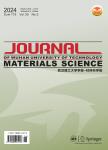Mechanical and Thermal Properties of Polysiloxanes and NBR Blend Elastomer
Mechanical and Thermal Properties of Polysiloxanes and NBR Blend Elastomer作者机构:School of Materials Science and EngineeringWuhan University of Technology Wuhan 430070China
出 版 物:《Journal of Wuhan University of Technology(Materials Science)》 (武汉理工大学学报(材料科学英文版))
年 卷 期:2006年第21卷第4期
页 面:92-94页
核心收录:
学科分类:08[工学] 0805[工学-材料科学与工程(可授工学、理学学位)] 080502[工学-材料学]
基 金:Funded by the Defense Pre-research Project of the"EleventhFive-Year-Plan"of China(51312040404)
主 题:NBR polysiloxanes tensile tests thermal stability
摘 要:A series of elastomers , based on NBR , polysiloxanes (PS) were prepared and characterized by tensile tests, thermogravimetry ( TG ) and differential scanning calorimetry ( DSC ). Two kinds of vulcanizing agent, DMDBH (2,5-dimethyl- 2,5-di ( t- butyl perory ) hexane ) and DCP ( dicumylperoxide ) were used to investigate the influence of different vulcanizing agents on properties of PS/ NBR. The addition of PS to NBR was found to improve the thermal stability and decrease the tensile strength of NBR. The tensile strength decreased conshterably while the elongation at break increased obviously with the increase of PS content. The series using DMDBH as vulcanizing agent showed a higher tensile strength and elongation at break than the series using DCP as vulcanizing agent. Simultaneity the thermal stability increased with the increase of PS content.



